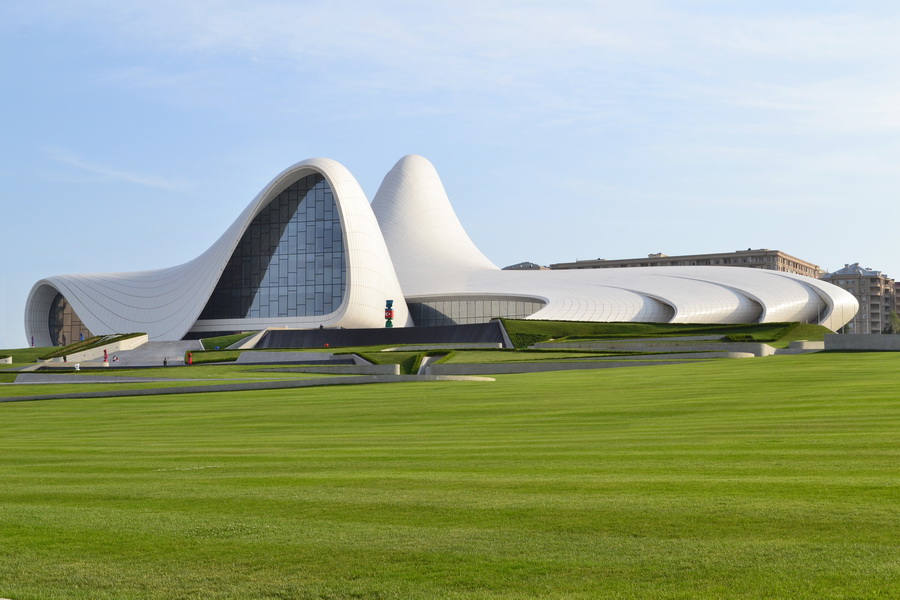
The Heydar Aliyev Cultural Center in Baku appears as though an extraterrestrial vessel has gracefully landed in the heart of the city. This massive, unconventional architectural wonder arrests the attention of first-time onlookers with its scale and novelty. Its seamless lines, variable volume and height, along with its distinct structure resembling mountain peaks adorned with sloping snow-capped descents, incite awe and admiration. The panoramas seen from both outside and within the complex could easily be mistaken for vistas from a ski resort. Further adding to the appeal of the place is the interplay of light and shadow, which creates unique experiences at different times of day.
Historical Notes
This stunning edifice was conceived in 2007 by globally renowned British architect, Zaha Hadid. She is an esteemed proponent of the deconstructivism style, a creative discipline that shapes her work and artistic endeavors. In designing the Heydar Aliyev Center, Hadid lent her support to the ideals of her equally famous predecessor, Antonio Gaudi, who was a vocal critic of stringent geometry in architecture, maintaining that nature is devoid of straight lines. The outcome of her efforts is a breathtaking architectural masterpiece that continues to astound visitors and locals alike. Listed in the top things to do in Baku, visiting the Heydar Aliyev Center allows guests to witness firsthand the perfect embodiment of modern architectural excellence and cultural tribute.
The decision to construct the Center stirred a public debate and drew a mixed bag of reactions from both architectural experts and the general public. The Center took the place of an erstwhile engineering plant, which necessitated relocating the facility. The workers of the factory protested through strikes, and spirited public discourse ensued regarding the appropriateness of erecting such a grandiose structure in place of a functioning cultural institution. Despite these controversies, the project proceeded and the construction was swiftly completed in a span of five years.
Architectural Splendor
The structural design is composed of interconnected concrete blocks with a plethora of sizable, spatial window frames. This endows visitors with an unusual experience of being in an expansive hall that simulates a finely polished, gargantuan cave. As guests traverse between the halls, they can bask in the harmony of flowing lines that surround them. Staircases, walls, floors, and ceilings seamlessly transition from one detail to another, uniting into a cohesive whole in a graceful ballet of light and shadow.
Zaha Hadid, with her Iraqi roots, bestows upon her distinct and memorable projects a direct reference to the intricate motifs and patterns found on the walls of ancient mosques and palaces. As such, a perfectly orchestrated symphony of images, shapes, and recurring patterns is granted a fresh lease of life. This philosophical concept in architectural vision inspires and instructs observers to discern beauty in unconventional creative solutions.
Exhibitions
The primary aim of establishing the Heydar Aliyev Center was to conserve and explore the Azerbaijani heritage, tracing its lineage from antiquity through to the present day. The center was founded as a memorial to Heydar Aliyev, the third president of Azerbaijan. As visitors approach the museum complex, they're greeted by a display of vintage automobiles, once used by the statesman in his official duties.
The cultural hub is composed of five exhibition halls, each one showcasing various facets of Azerbaijani tradition and heritage. These include national attire, traditional musical instruments, handmade crafts, and a wide array of creative expressions from across the country. Art and culture intertwine through a tapestry of installations and photographs, aiming first to acquaint visitors with the history of Azerbaijan, before progressively immersing them in a wealth of knowledge and rich experiences. Exhibits feature photographic galleries of national cuisine, displays of traditional men's and women's clothing, carpets, and musical instruments. A special feature is an intricately detailed miniature depiction of Azerbaijan, capturing 45 significant architectural and historical landmarks from Baku and other cities throughout the country.
Additionally, the Center frequently hosts thematic exhibitions that showcase the works of esteemed Azerbaijani and global artists. The expansive Center encompasses two conference areas, generous lecture halls across three floors, the Heydar Aliyev Museum, exhibition spaces, and a restaurant complex.
For aficionados of contemporary architecture, as well as those with a desire to deepen their understanding of Azerbaijan's history, the Heydar Aliyev Center is a must-visit destination. The daring architectural design of the Center set against the historical narratives it embodies can evoke a range of emotions, often quite contrasting. However, when viewed in its entirety, the intricate blend of past, present, and future becomes apparent and compelling. Even for those whose interests may not typically lie in historical exploration, a visit to the Center is still highly recommended. It promises to be an enriching and unforgettable experience. You won't leave disappointed!

